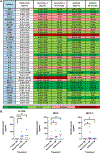Secreted factors induced by PKC modulators do not indirectly cause HIV latency reversal
- PMID: 36842270
- PMCID: PMC10103183
- DOI: 10.1016/j.virol.2023.02.009
Secreted factors induced by PKC modulators do not indirectly cause HIV latency reversal
Abstract
HIV can establish a long-lived latent infection in cells harboring integrated non-expressing proviruses. Latency reversing agents (LRAs), including protein kinase C (PKC) modulators, can induce expression of latent HIV, thereby reducing the latent reservoir in animal models. However, PKC modulators such as bryostatin-1 also cause cytokine upregulation in peripheral blood mononuclear cells (PBMCs), including cytokines that might independently reverse HIV latency. To determine whether cytokines induced by PKC modulators contribute to latency reversal, primary human PBMCs were treated with bryostatin-1 or the bryostatin analog SUW133, a superior LRA, and supernatant was collected. As anticipated, LRA-treated cell supernatant contained increased levels of cytokines compared to untreated cell supernatant. However, exposure of latently-infected cells with this supernatant did not result in latency reactivation. These results indicate that PKC modulators do not have significant indirect effects on HIV latency reversal in vitro and thus are targeted in their latency reversing ability.
Keywords: Bryostatin-1; HIV; Kick-and-kill approach; Latency reversal; PKC modulators; SUW133.
Copyright © 2023 The Authors. Published by Elsevier Inc. All rights reserved.
Conflict of interest statement
Declaration of competing interest The authors declare the following financial interests/personal relationships which may be considered as potential competing interests: Stanford University has filed patent applications on SUW133 and related technology, which has been licensed by Neurotrope BioScience and Bryologyx Inc. P.A.W. is an adviser to both companies and a cofounder of the latter. J.A.Z. is a cofounder of CDR3 Therapeutics and is on the SAB of Bryologyx.
Figures



References
Publication types
MeSH terms
Substances
Grants and funding
LinkOut - more resources
Full Text Sources
Medical
Research Materials

